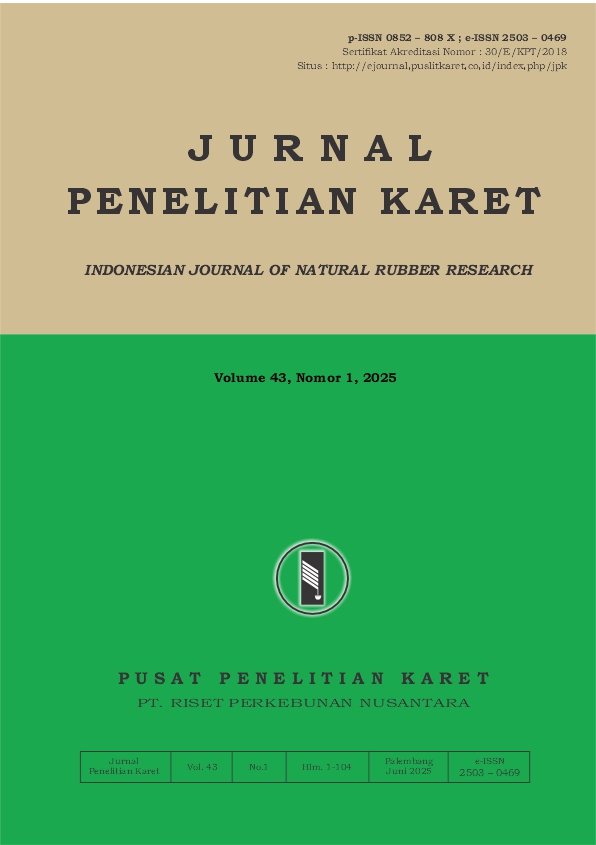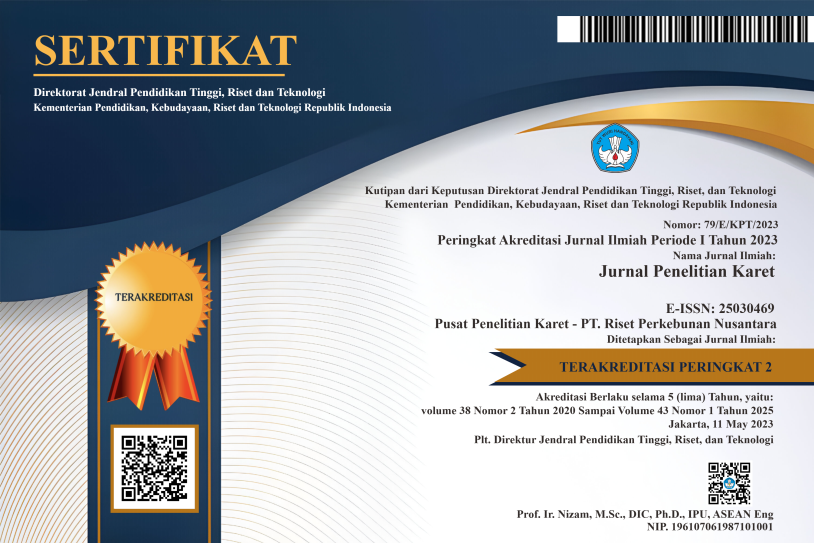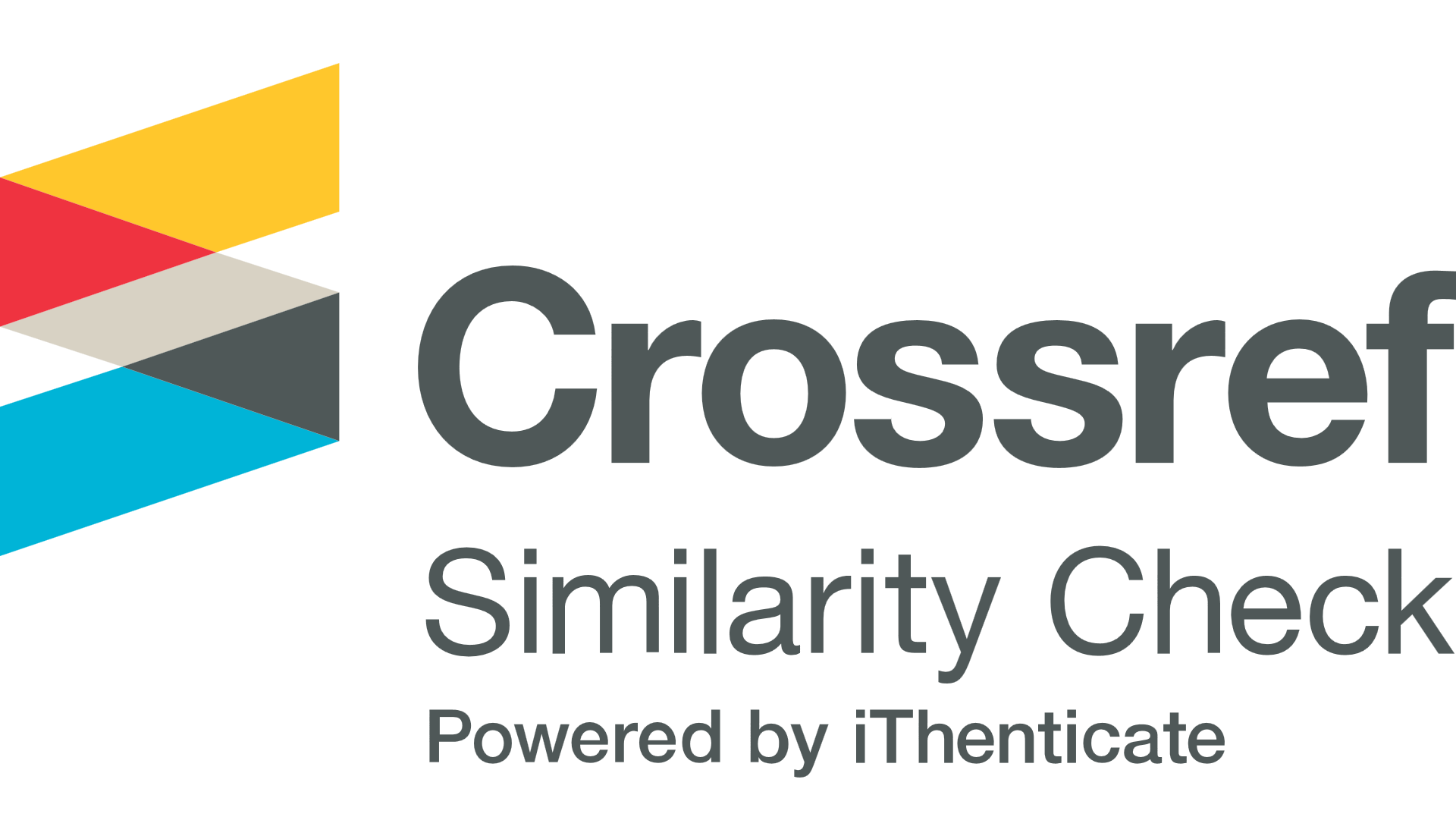MODEL ALOMETRIK UNTUK PENDUGAAN LUAS DAUN KARET
DOI:
https://doi.org/10.22302/ppk.jpk.v43i1.940Keywords:
Hevea brasiliensis, IRR 112, koefisien daun, metode non-destruktifAbstract
Metode yang praktis, cepat, dan tidak merusak sampel sangat diperlukan dalam mengukur luas daun karet. Luas daun karet merupakan salah satu parameter pertumbuhan tanaman yang diperlukan untuk melakukan analisis pertumbuhan dan proses fisiologis tanaman termasuk laju fotosintesis dan transpirasi. Salah satu metode non-destruktif yang banyak digunakan untuk memperkirakan luas daun adalah metode persamaan alometrik menggunakan perhitungan regresi. Penelitian ini bertujuan untuk mengetahui nilai koefisien daun (k) untuk memprediksi luas daun karet klon IRR 112. Penelitian ini dilakukan dari Juli hingga Agustus 2021 di Pusat Penelitian Karet, Sembawa, Sumatera Selatan, Indonesia. Pengukuran luas daun dilakukan dengan metode gravimetri. Hasil penelitian kemudian digunakan untuk menentukan koefisien daun (k) menggunakan data panjang dan lebar daun. Kalibrasi dan validasi dilakukan dengan menggunakan parameter goodness of match (GOM), koefisien korelasi Pearson (R), koefisien determinasi (R2), dan root mean square error (RMSE). Hasil penelitian menunjukkan bahwa nilai k untuk klon karet IRR 112 masing-masing adalah 0,622. Selanjutnya, validasi model menunjukkan bahwa nilai GOM, R, dan R2 berada di atas 0,98 serta RMSE sekitar 1,7 cm2. Fakta-fakta ini menunjukkan bahwa model ini cukup akurat untuk memprediksi luas daun dari data panjang dan lebar daun.
References
Bakhshandeh, E., Ghadiryan, R., & Kamkar, B. (2010). A Rapid and Non-Destructive Method to Determine the Leaflet, Trifoliate and Total Leaf Area of Soybean. The Asian and Australasian Journal of Plant Science and Biotechnology, 4(1), 19–23.
Bazaz, A. M., Fariman, Z. K., & Bannayan, M. (2011). Modeling individual leaf area of basil (Ocimum basilicum) using different methods. International Journal of Plant Production, 5(4), 439–447.
Bhatt, M., & Chanda, S. V. (2003). Prediction of leaf area in Phaseolus vulgaris by non-destructive method. Bulgarian Journal of Plant Physiology, 29(1–2), 96–100.
Cahyo, A. N., Babel, M. S., Datta, A., Prasad, K. C., & Clemente, R. (2016). Evaluation of Land and Water Management Options to Enhance Productivity of Rubber Plantation using WaNuLCAS Model. AGRIVITA Journal of Agricultural Science, 38(1),93–103. https://doi.org/10.17503/agrivita.v38i1.583
Chicco, D., Warrens, M. J., & Jurman, G. (2021). The coefficient of determination R-squared is more informative than SMAPE, MAE, MAPE, MSE and RMSE in regression analysis evaluation. PeerJ. Computer Science, 7, e623. https://doi.org/10.7717/peerj-cs.623
Dey, A. K., Guha, P., Sharma, M., & Meshram, M. R. (2019). Comparison of different Methods of In-situ Leaf Area Measurement of Betel Leaf (Piper betle L.). International Journal of Recent Technology and Engineering, 7(6), 1512–1516.
Gao, J., Zhao, B., Dong, S., Liu, P., Ren, B., & Zhang, J. (2017). Response of Summer Maize Photosynthate Accumulation and Distribution to Shading Stress Assessed by Using 13CO2 Stable Isotope Tracer in the Field. Frontiers in Plant Science, 8, 1821. https://doi.org/10.3389/fpls.2017.01821
He, J., Reddy, G. V. P., Liu, M., & Shi, P. (2020). A general formula for calculating surface area of the similarly shaped leaves: Evidence from six Magnoliaceae species. Global Ecology and Conservation, 23, e01129. https://doi.org/10.1016/j.gecco.2020.e01129
Karatassiou, M., Ragkos, A., Markidis, P., & Stavrou, T. (2015). A Comparative Study of Methods for the Estimation of the Leaf Area in Forage Species. Proceeding of the 7th International Conference on Information and Communication Technologies in Agriculture, Food and Environment (HAICTA 2015), 1498, 326–332.
Khasanah, N., Wijaya, T., June, T., Lusiana, B., & Van Noordwijk, M. (2008). Growth of Rubber (Hevea brasiliensis) in Monoculture and Mixed Systems with Acacia (Acacia mangium) A Case Study in Sembawa, South Sumatra: II. Simulation Using WaNuLCAS Model. Indonesian Journal of Natural Rubber Research, 26(1), Article 1.
Laga, H., Kurtek, S., Srivastava, A., & Miklavcic, S. J. (2014). Landmark-free statistical analysis of the shape of plant leaves. Journal of Theoretical Biology, 363, 41–52. https://doi.org/10.1016/j.jtbi.2014.07.036
Li, X., Schmid, B., Wang, F., & Paine, C. E. T. (2016). Net Assimilation Rate Determines the Growth Rates of 14 Species of Subtropical Forest Trees. PLOS ONE, 11(3), e0150644. https://doi.org/10.1371/journal.pone.0150644
Lippe, M., Dung, N. V., Vien, T. D., Kien, T. T., Hilger, T., & Cadisch, G. (2007). WaNuLCAS Modelling of Improved Swidden Agriculture Systems by Indigenous Fallow Management with Melia azedarach in the Uplands of Ban Tat, Northern Viet Nam. Proceedings of International Agricultural Research for Development Conference, 1.
Loague, K., & Green, R. E. (1991). Statistical and graphical methods for evaluating solute transport models: Overview and application. Journal of Contaminant Hydrology, 7(1–2), 51–73. https://doi.org/10.1016/0169-7722(91)90038-3
Maylani, E. D., Yuniati, R., & Wardhana, W. (2020). The Effect of leaf surface character on the ability of water hyacinth, Eichhornia crassipes (Mart.) Solms. To transpire water. IOP Conference Series: Materials Science and Engineering, 902, 012070. https://doi.org/10.1088/1757-899X/902/1/012070
Michalczyk, A. (2008). Parameterisation and Modelling of Growth and Yield Development of Mango (Mangifera indica L.) in North Thailand with Application of the WaNuLCAS Model. Humboldt-Universität zu Berlin.
Microsoft Corporation. (2019). Microsoft Office Excel 2019 (Version 2019) [Windows 10]. Microsoft Corporation.
Misle, E., Kahlaoui, B., Hachicha, M., & Alvarado, P. (2013). Leaf area estimation in muskmelon by allometry. Photosynthetica, 51(4), 613–620. https://doi.org/10.1007/s11099-013-0062-x
Montgomery, E. G. (1911). Correlation studies of corn. (Annual Report 24; pp. 108–159). Nebraska Agricultural Experimental Station.
Musa, U. T., Yusuf, M., & Ojo, S. O. (2020). Leaf Area Determination for Sesame (Sesamum indicum), Wheat (Triticum aestivuma), Groundnut (Arechis hypogaea) and Bambaranut (Vigna subterrane) Crops Using Linear Measurements. Journal of Biology, Agriculture and Healthcare, 10(12), 20–26. https://doi.org/10.7176/JBAH/10-12-04
Pandey, S. K., & Singh, H. (2011). A Simple, Cost-Effective Method for Leaf Area Estimation. Journal of Botany, 2011, 1–6. https://doi.org/10.1155/2011/658240
Pasaribu, S. A., & Suhendry, I. (2018). Identification of Rubber Clones Based on Various Leaf Characteristic. Indonesian Journal of Natural Rubber Research, 36(1), 37–50. https://doi.org/10.22302/ppk.jpk.v36i1.552
Poorter, H., Anten, N. P. R., & Marcelis, L. F. M. (2013). Physiological mechanisms in plant growth models: Do we need a supra-cellular systems biology approach? Plant, Cell & Environment, 36(9), 1673–1690. https://doi.org/10.1111/pce.12123
Sadik, S. K., AL-Taweel, A. A., & Dhyeab, N. S. (2011). New Computer Program for Estimating Leaf Area of Several Vegetable Crops. American-Eurasian Journal of Sustainable Agriculture, 5(2), 304–309.
Suhendry, I., & Pasaribu, S. A. (2009). Identifikasi klon karet melalui karakteristik daun. 1. Variasi ukuran daun. Jurnal Penelitian Karet, 27(1), 1–20.
Susilo, D. E. H. (2015). Identifikasi Nilai Konstanta Bentuk Daun untuk Pengukuran Luas Daun Metode Panjang Kali Lebar pada Tanaman Hortikultura di Tanah Gambut. Anterior Jurnal, 14(2), 139–146. https://doi.org/10.33084/anterior.v14i2.178
Zhao, C., Chan, S. S. F., Cham, W.-K., & Chu, L. M. (2015). Plant identification using leaf shapes—A pattern counting approach. Pattern Recognition, 48(10), 3203–3215. https://doi.org/10.1016/j.patcog.2015.04.004
Downloads
Published
How to Cite
Issue
Section
License
Copyright (c) 2024 Andi Nur Cahyo

This work is licensed under a Creative Commons Attribution-ShareAlike 4.0 International License.
Submission of a original research article in Jurnal Penelitian Karet implies that the submitted  manuscript has not been published in any scientific journal (except being part of the abstract, thesis, or report). The submitted manuscript also is not under consideration for publication elsewhere. All co-authors involve in the publication of the manuscript should give their approval.
Once, the manuscript is accepted and then published in Jurnal penelitian Karet, the Author(s) keep hold the copyright and retain publishing right without restrictions.
Author(s) and Jurnal Penelitian Karet users are allowed to multiply the published manuscript. The journal users are also permissible to share the published manuscript with an acknowledgement to the Author(s). The Editorial Boards suggest that the Authors should manage patent before publishing their new inventions.

















